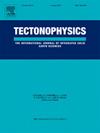Delineation of crustal structure and composition in the Northwest Himalaya and adjoining Indo-Gangetic Plain
IF 2.7
3区 地球科学
Q2 GEOCHEMISTRY & GEOPHYSICS
引用次数: 0
Abstract
We utilize the H-k stacking technique on P-wave receiver functions from 38 seismic stations to estimate the crustal thickness and Vp/Vs ratio in the NW Himalaya and the adjoining Indo-Gangetic Plain (IGP). We observe varying crustal thickness from ∼29 km in the IGP to ∼50–60 km in the Higher Himalayan Crystalline Zone. An abrupt crustal thickening of ∼47–54 km observed near Jwalamukhi Thrust is due to significant crustal shortening along the fault. Inferred higher Vp/Vs values of 1.78–1.84 in the IGP may result from the underplating of mafic materials in the Precambrian. The presence of thick sediments towards the Himalayan Frontal Thrust, further, contributes to the extremely high Vp/Vs of 1.89–2.02. The intermediate Vp/Vs of ∼1.74 in the Sub Himalayan Zone indicates the reworking of the mafic crust by delamination of the lower crust or the greater influence of the overlying Himalayan wedge, comprised of felsic to intermediate rock composition. Higher Vp/Vs values in the Kishtwar (1.81–1.93) and Kashmir Valley (1.80–1.93) are possibly due to the presence of volcanic rocks and the effect of the mid-crustal low-velocity layer. Integration of our results with previous studies reveals a heterogenous crustal structure characterized by both arc-normal and arc-parallel variations which may have resulted from varying convergence rates and the influence of subsurface extension of active transverse ridges beneath the Himalaya. The varying Vp/Vs values may result from diverse crustal rock compositions and partial melt/fluid zones. These partial melts alter the mechanical properties of rocks leading to brittle failure and thus promoting seismicity.

喜马拉雅西北部和邻近的印度-恒河平原的地壳结构和组成的圈定
利用38个地震台站p波接收函数的H-k叠加技术,估算了喜马拉雅西北部及邻近的印度-恒河平原(IGP)的地壳厚度和Vp/Vs比值。我们观察到地壳厚度从IGP的~ 29 km到高喜马拉雅结晶带的~ 50-60 km不等。在Jwalamukhi逆冲附近观测到的地壳突然增厚约47-54 km,这是由于地壳沿断层明显缩短所致。推断IGP中较高的Vp/Vs值为1.78 ~ 1.84,可能是前寒武纪基性物质下覆的结果。喜马拉雅锋面逆冲方向厚沉积的存在进一步导致了极高的Vp/Vs值(1.89 ~ 2.02)。亚喜马拉雅带的中间Vp/Vs值为~ 1.74,表明下地壳的剥离作用对基性地壳进行了改造,或受上覆喜马拉雅楔块的较大影响,由长英质至中间岩石组成。Kishtwar(1.81 ~ 1.93)和Kashmir Valley(1.80 ~ 1.93)较高的Vp/Vs值可能是由于火山岩的存在和中地壳低速层的影响。结合前人的研究结果,揭示了一个具有弧正平行变化特征的非均质地壳结构,这可能是由不同的辐合速率和喜马拉雅下活动横向脊的地下伸展的影响造成的。不同的Vp/Vs值可能与不同的地壳岩石成分和部分熔融/流体带有关。这些部分熔化改变了岩石的力学性质,导致脆性破坏,从而促进了地震活动。
本文章由计算机程序翻译,如有差异,请以英文原文为准。
求助全文
约1分钟内获得全文
求助全文
来源期刊

Tectonophysics
地学-地球化学与地球物理
CiteScore
4.90
自引率
6.90%
发文量
300
审稿时长
6 months
期刊介绍:
The prime focus of Tectonophysics will be high-impact original research and reviews in the fields of kinematics, structure, composition, and dynamics of the solid arth at all scales. Tectonophysics particularly encourages submission of papers based on the integration of a multitude of geophysical, geological, geochemical, geodynamic, and geotectonic methods
 求助内容:
求助内容: 应助结果提醒方式:
应助结果提醒方式:


